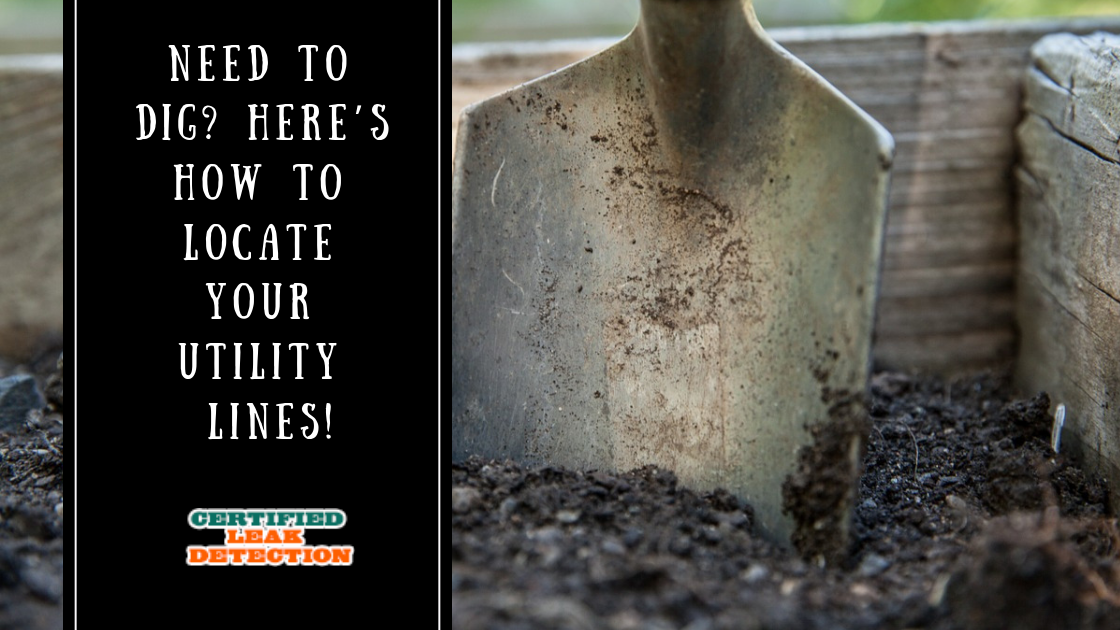Ever see one of those old movies where a ranch owner took a shovel to his land to dig a well and struck oil? The inconvenience of being drenched in black gold, Texas tea, etc., was more than offset by striking it rich. But if you do likewise on your property, it won’t be oil, and it will be a big problem – not just for you, but for everyone on your grid. While most people within city limits don’t dig wells, popular DIY projects include landscaping, building a deck, creating a pond and installing a mailbox. Any of these activities – and many more – involve the risk of accidentally hitting an underground utility line. Here’s how to locate your utility lines and dig safely.
What kind of lines and pipes run under your property?
Depending upon where you live, certain service lines – such as electrical – may be underground. For the purpose of this blog post, however, we’ll list all possibilities:
- Gas lines
- Water pipes
- Sewer/septic system pipes
- Irrigation system piping
- Telecommunications lines
- Cable TV/internet lines
How hard is it to break an underground water pipe?
You don’t need to possess superhero strength to break a water pipe while digging a hole to plant that nice palm tree. PVC pipes are durable under normal conditions, but not indestructible against the business end of a shovel. And a copper pipe that’s sprung pinhole leaks is already weakened, making it relatively easy to break. Whether it’s a city water line to your house or your own irrigation system pipe, you’re responsible for repairs – which will need to be made immediately, on an emergency basis, at an even higher cost.
Avoiding buried treasure
Unfortunately, there’s no map with X-marks-the-spot for homeowners. In this case, X would mark the spot(s) where you don’t want to dig. Fortunately, there is 811 – a national free service that directs callers to their local call center. Call a few days in advance, and tell the operator where you’re planning to dig. Professional locators will be sent to your dig site to mark the approximate location of buried lines with flags or paint.
The 811 website provides a map and contact info for each state. Click here for Florida.
Upside: 811 eliminates the guesswork of locating utility lines on your property. Downside: Impatient people or those who like to tackle projects on impulse probably won’t like the waiting period.
However, as the 811 website helpfully states: “Always call 811 before you start any digging project! You can help avoid injury, expense, embarrassment and a very inconvenient day without critical services like electricity, internet or phone.”
Once the utility lines are identified and marked, 811 advises the following:
“Make sure to always dig carefully around the marks, not on them. Some utility lines may be buried at a shallow depth, and an unintended shovel thrust can bring you right back to square one – facing potentially dangerous and/or costly consequences. Don't forget that erosion or root structure growth may shift the locations of your utility lines, so remember to call again each time you are planning a digging job. Safe digging is no accident!”
General safe digging guidelines
Guidelines gleaned from professional landscapers are offered by HowStuffWorks.
Standard depths for certain lines are as follows:
One foot down (30 cm) – cable lines and telephone lines in conduit
Two feet down (61 cm) – electricity, sewage and telephone lines without conduits.
Three feet down (91 cm) – more electrical lines, water pipes and sewer lines.
Note: Gas lines might be encountered at any depth, as there is no standard. Do not dig without calling 811. Even then, use extreme caution.
Chicago Tribune reporter Tim Johnson has additional advice: “Digging near utility boxes can be very tricky, as there will be a number of lines coming in from different directions. It is easy to cut your service line or your neighbor's. Use a trowel to dig very carefully to find the lines.
“Use great caution when planting near a buried electrical power line. It is best to use a wood or fiberglass shovel, rather than a metal one …”
Advice about lawn irrigation systems
If your home has a lawn irrigation system, be aware that the locator who 811 sends will not include it. Consult the contractor who installed your irrigation system if you are uncertain where those lines are. Johnson recommends the following: “The black polyvinyl piping used in many irrigation systems is very easy to cut with a spade. Irrigation systems with PVC pipe will better withstand a nick with a spade, but you still must be careful.”
What happens if you do break a water line?
You have two choices: call a pro immediately (highly recommended) or repair it yourself. The second option is practical only if you have hand-on experience in this type of work, and the damage results in a slow leak, not a gusher. Today’s Homeowner offers step-by-step DIY instructions on underground pipe repair, but it’s advisable to read it now to decide whether you can do this with confidence, if the need arises.
Should you decide to call a professional, Certified Leak Detection is experienced in leak detection and repair for Orlando, Longwood, Lake Mary, Sanford, Kissimmee, Clermont and Winter Springs. Trusted by homeowners throughout Central Florida, our team is ready to answer your call. Contact us for quick, reliable service.

